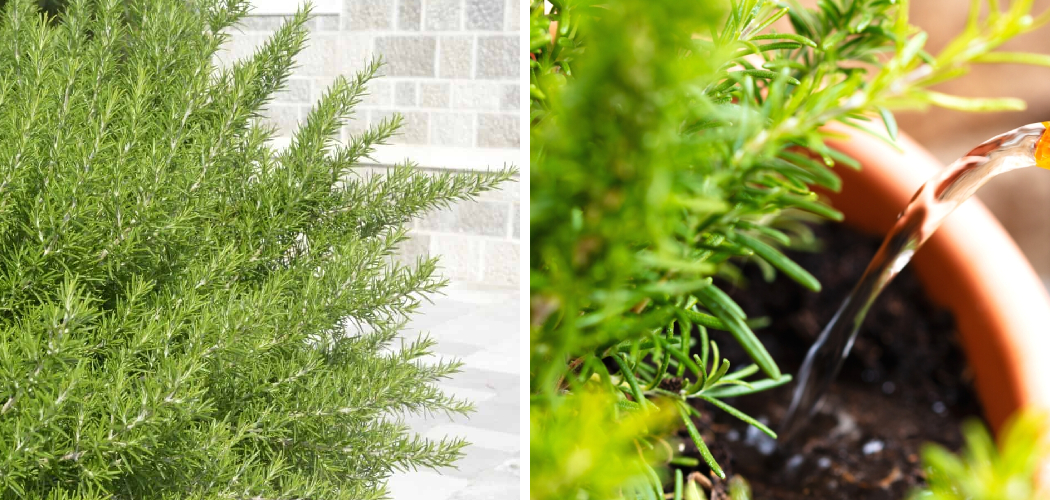To water rosemary, provide consistent moisture by watering deeply when the top inch of soil feels dry. In addition, ensure the plant has good drainage and avoid overwatering to prevent root rot.
Rosemary, a fragrant evergreen herb, is a popular addition to herb gardens and culinary dishes alike. Known for its pine-like aroma and versatile flavor, rosemary thrives in well-draining soil and prefers consistent moisture. The key to successfully watering rosemary is to provide enough water to keep the soil evenly moist but not saturated.
This can be achieved by watering deeply when the top inch of soil feels dry to the touch. It is important to avoid overwatering, which can lead to root rot, a common issue in rosemary plants. By following these simple watering guidelines, you can ensure that your rosemary plant remains healthy and vibrant.

Understanding The Watering Needs Of Rosemary
Understanding the watering needs of rosemary is essential for maintaining its health and vitality. Factors like climate, soil type, and plant size influence the water requirements of rosemary. To determine the right watering schedule for your rosemary plant, consider the following guidelines.
First, ensure that the soil is evenly moist, but not waterlogged. Water the plant thoroughly, allowing the excess water to drain away. Avoid overwatering, as it can lead to root rot and other diseases. Instead, allow the soil to dry out slightly between waterings.
As a general rule, water rosemary about once a week in dry conditions, but adjust the frequency based on the plant’s needs. By following these precautions and understanding the specific needs of your rosemary plant, you can ensure its healthy growth and longevity.
Signs Of Overwatering And Underwatering Rosemary
One common mistake when watering rosemary is overwatering, which can be identified by yellowing leaves and root rot. Overwatered rosemary may also have a drooping appearance and a damp, musty smell. On the other hand, underwatered rosemary shows signs such as wilted leaves, browning, and a dry, brittle texture.
To avoid these issues, it is important to water rosemary only when the top inch of soil feels dry to the touch. Use a well-draining soil mix and ensure that the pot has drainage holes. When watering, pour water slowly at the base of the plant until it reaches the root zone.
Remember to let the excess water drain away. By following these guidelines, you can ensure that your rosemary receives the appropriate amount of water for its healthy growth.
Watering Techniques For Optimal Rosemary Growth
Watering your rosemary plants at the right time of the day is crucial for optimal growth. For potted rosemary, make sure the soil is evenly moist but not waterlogged. In-ground rosemary requires deep watering to reach the root zone. Be mindful of the amount of water you use, as overwatering can lead to root rot.
It’s best to use a drip irrigation system or trickle hose to provide a slow and steady flow of water. Avoid watering from above, as wet leaves can increase the risk of fungal diseases. Regularly check the soil moisture to ensure it doesn’t dry out completely.
With proper watering techniques, you can help your rosemary plants thrive and produce fragrant foliage for culinary delights. So remember, timing and moderation are key when it comes to watering your rosemary plants.
How to Water Rosemary: Step by Step Guide
Choosing The Right Watering Tools For Rosemary
Choosing the right watering tools for rosemary is crucial for its optimal growth and health. Different watering methods have their own advantages and disadvantages. It is important to consider suitable tools and equipment that will ensure efficient water application to rosemary.
Some commonly used watering tools include watering cans, drip irrigation systems, and soaker hoses. Watering cans allow for precise control and prevent water from splashing onto the foliage. Drip irrigation systems provide a slow and steady water supply directly to the roots, promoting deep and thorough watering.
Soaker hoses deliver water directly to the soil, reducing evaporation and ensuring proper hydration. To ensure efficient water application, it is advisable to water deeply but infrequently, allowing the soil to dry out slightly between waterings. Additionally, avoiding overhead watering can help prevent potential foliar diseases.
Proper watering techniques will help your rosemary thrive and yield flavorful leaves for your culinary creations.
Supplementary Watering Tips For Healthy Rosemary
Rosemary is an herb that requires proper watering for healthy growth. A supplementary watering tip is to utilize mulch, which helps retain moisture in the soil. Another beneficial method is rainwater harvesting, as it provides natural hydration while also reducing water wastage.
Proper watering practices are essential to prevent water-related diseases in rosemary. By avoiding excessive watering and ensuring good drainage, you can protect the plant from root rot and other issues. It’s important to monitor the soil moisture and water the plant only when necessary.
With these watering tips, you can maintain the health and vitality of your rosemary plant.
Adjusting Watering Techniques For Climate And Seasonal Changes
Watering rosemary in hot and dry climates requires special attention. In these conditions, it’s crucial to water deeply but infrequently to promote healthier root growth. Adjusting watering techniques becomes even more critical during winter and cold weather conditions when rosemary requires less water.
It’s important to strike a balance to prevent overwatering or underwatering. Adapting to rainy seasons is essential to avoid waterlogging, which can lead to root rot. When rainfall is abundant, it’s best to reduce irrigation frequency and duration accordingly. By understanding the needs of rosemary in different climates and seasons, you can provide the optimal amount of water to ensure its healthy growth.
Proper watering techniques are key to maintaining robust and flavorful rosemary plants throughout the year.
Troubleshooting Common Watering Issues For Rosemary
Rosemary is a delicate herb that requires proper watering to thrive. One common issue is root rot and fungus, which can be addressed by ensuring proper drainage for your rosemary plant. Avoid overwatering and consider using a well-draining soil mix to prevent these problems.
Another problem that arises is a dehydrated rosemary plant. If your rosemary appears dried out and wilted, it may need a good soak in water. Water deeply until the soil is moist throughout and allow the excess water to drain away.
Be cautious not to overwater, as this can also lead to root rot. By addressing these persistent watering issues, you can ensure the health and vitality of your rosemary plant.
Frequently Asked Questions For How To Water Rosemary
How Often Should I Water Rosemary?
Rosemary should be watered once a week during the growing season. However, it is important to check the moisture level of the soil before watering to avoid overwatering. The soil should be slightly dry before watering again.
Can I Water Rosemary From Overhead?
It is best to avoid watering rosemary from overhead as it can lead to fungal diseases. Instead, water the plant at the base, allowing the water to reach the roots directly. This will help prevent moisture-related issues and promote healthy growth.
Should I Water Rosemary In Winter?
During winter, rosemary enters a dormant phase and requires less water. It is advisable to reduce the frequency of watering to once every two to three weeks. Ensure that the soil is completely dry before watering to prevent waterlogged conditions.
Can Rosemary Tolerate Dry Conditions?
Rosemary is a drought-tolerant plant and can survive in dry conditions. In fact, it prefers well-draining soil and can handle dry spells. However, it is important to water the plant regularly during the growing season to promote healthy growth and prevent wilting.
Conclusion
To sum up, watering rosemary plants is a critical task that requires proper attention and care. By following the guidelines mentioned in this blog post, you can ensure the healthy growth and longevity of your rosemary plant. Remember to water the plant deeply and allow the soil to dry out slightly between each watering.
Providing adequate drainage, using the right watering tools, and keeping an eye on the weather conditions are essential factors to consider. Furthermore, understanding the specific water requirements of rosemary and adjusting your watering schedule accordingly will help prevent diseases and promote optimal growth.
By maintaining a balance between overwatering and underwatering, you can enjoy a thriving rosemary plant that will enhance the beauty of your garden and provide fresh herbs for your culinary endeavors.

